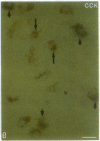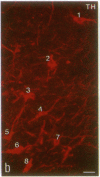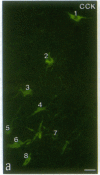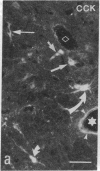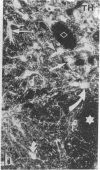Abstract
The ventral mesencephalons of hamster, guinea pig, cat, monkey, and several humans with and without the diagnosis of schizophrenia were analyzed with in situ hybridization and immunohistochemistry. Extensive codistribution of cholecystokinin mRNA and tyrosine hydroxylase [L-tyrosine, tetrahydropteridine: oxygen oxidoreductase (3-hydroxylating), EC 1.14.16.2] mRNA was observed in cats and monkeys as well as in all five human subjects with the diagnosis of schizophrenia and in two out of five control brains. Double labeling revealed coexistence of the two markers in cat, monkey, and human. No cholecystokinin mRNA or cholecystokinin peptide was detected in the substantia nigra/ventral tegmental area of the hamster or guinea pig, even after acute and chronic neuroleptic treatment.
Full text
PDF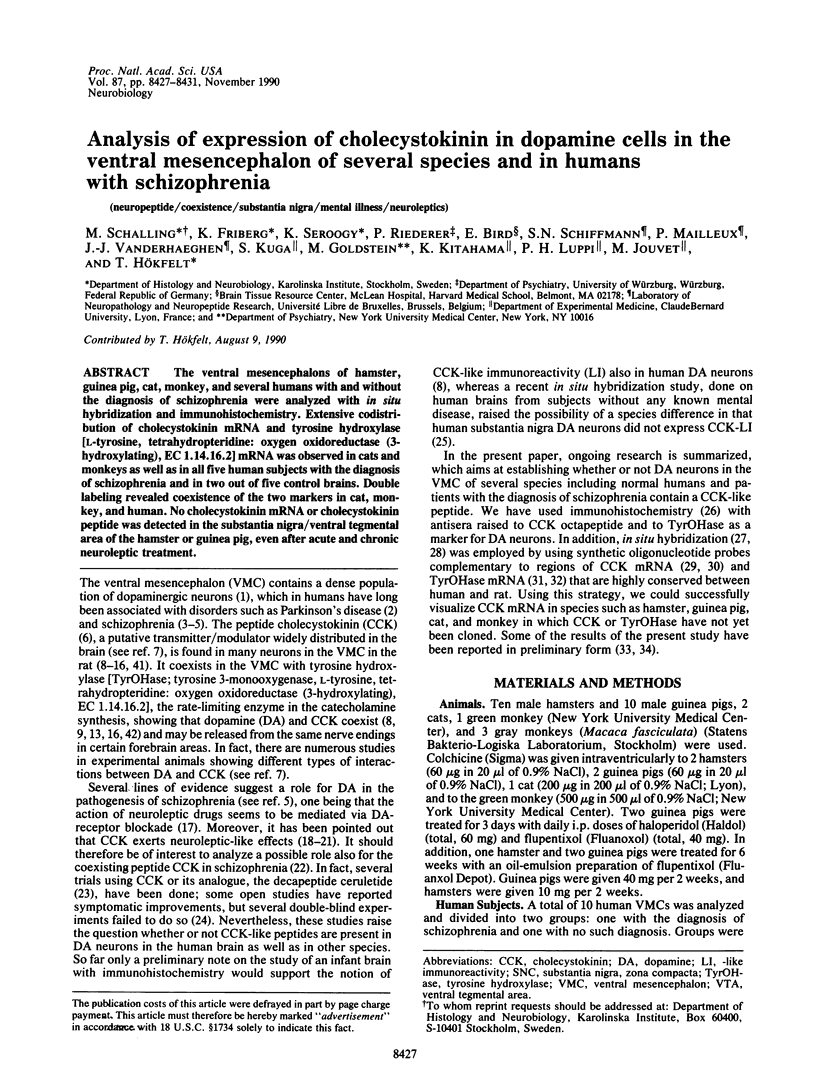
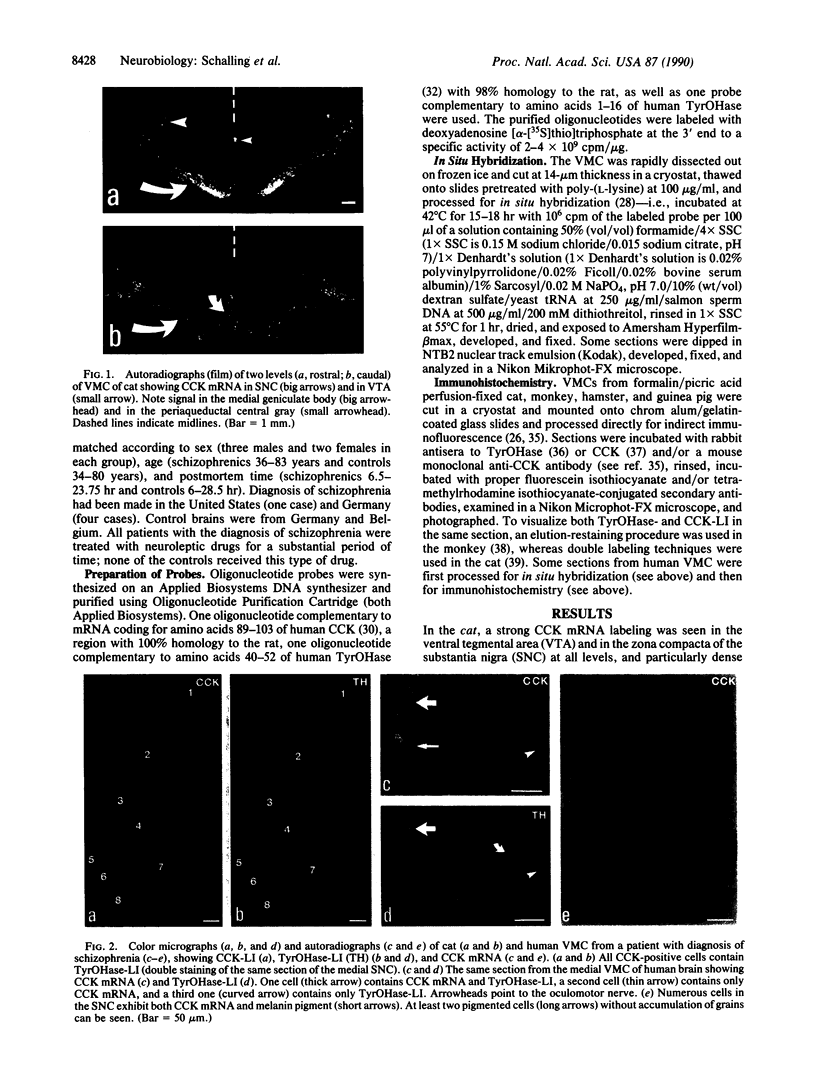
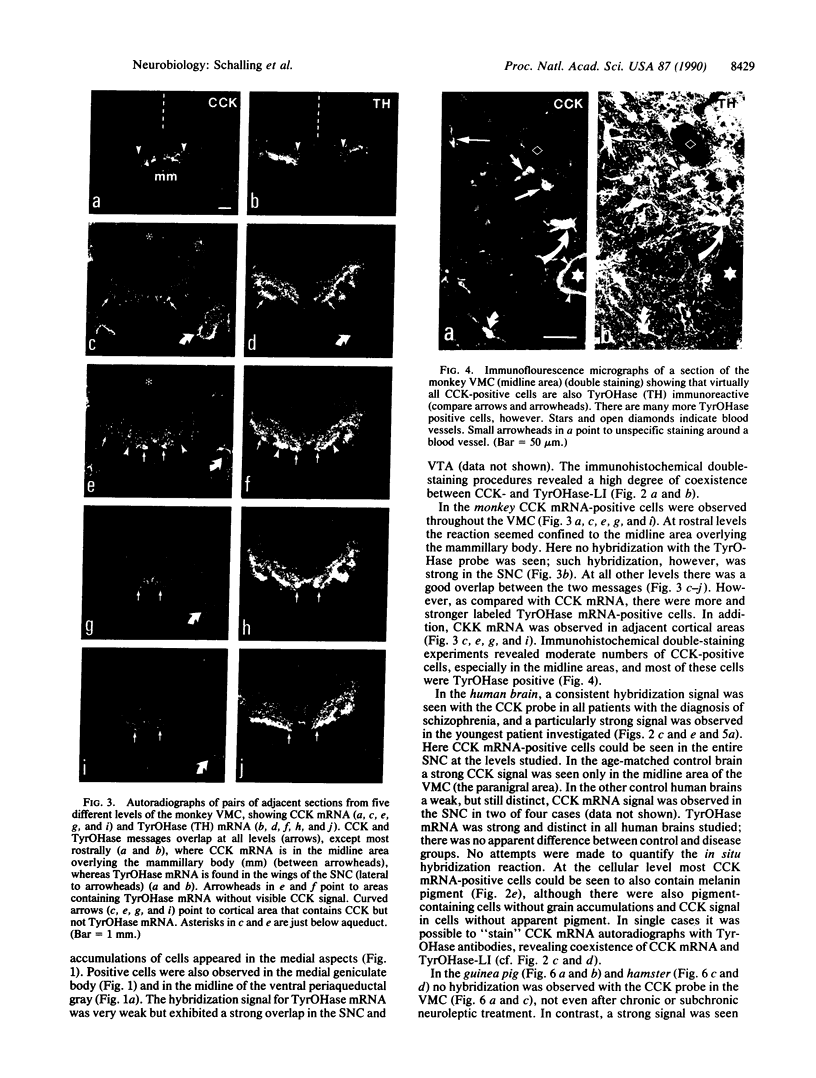
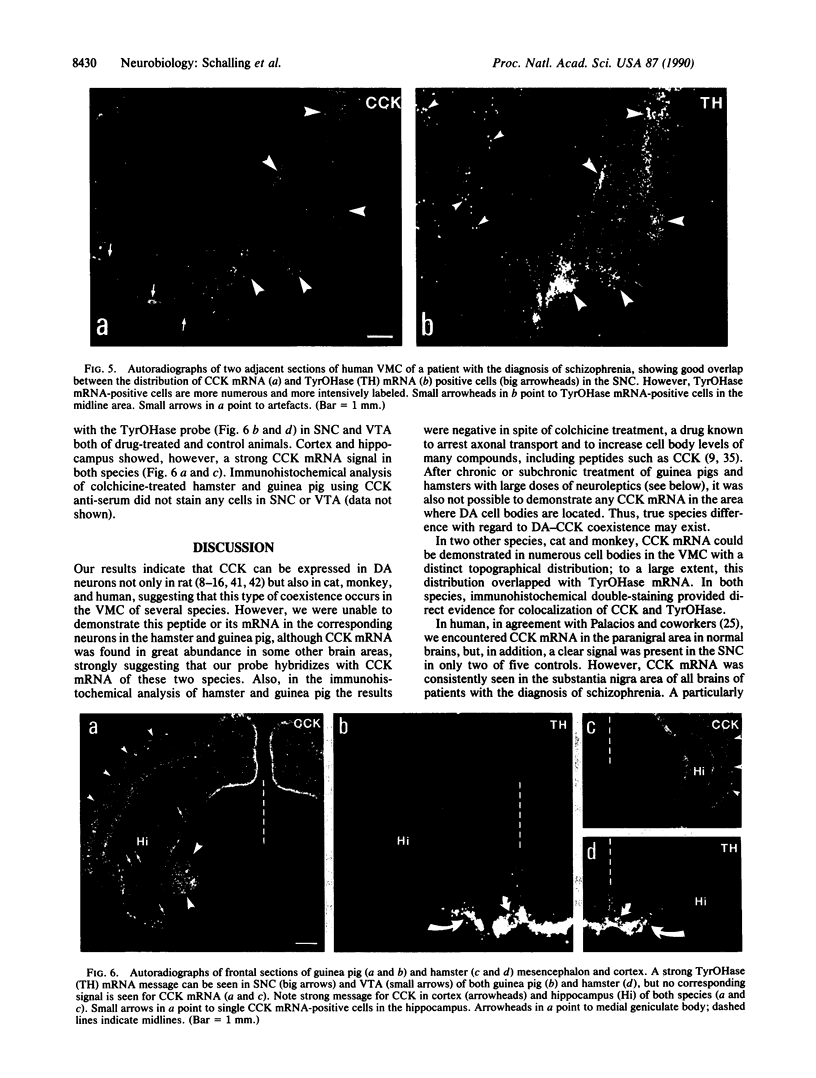
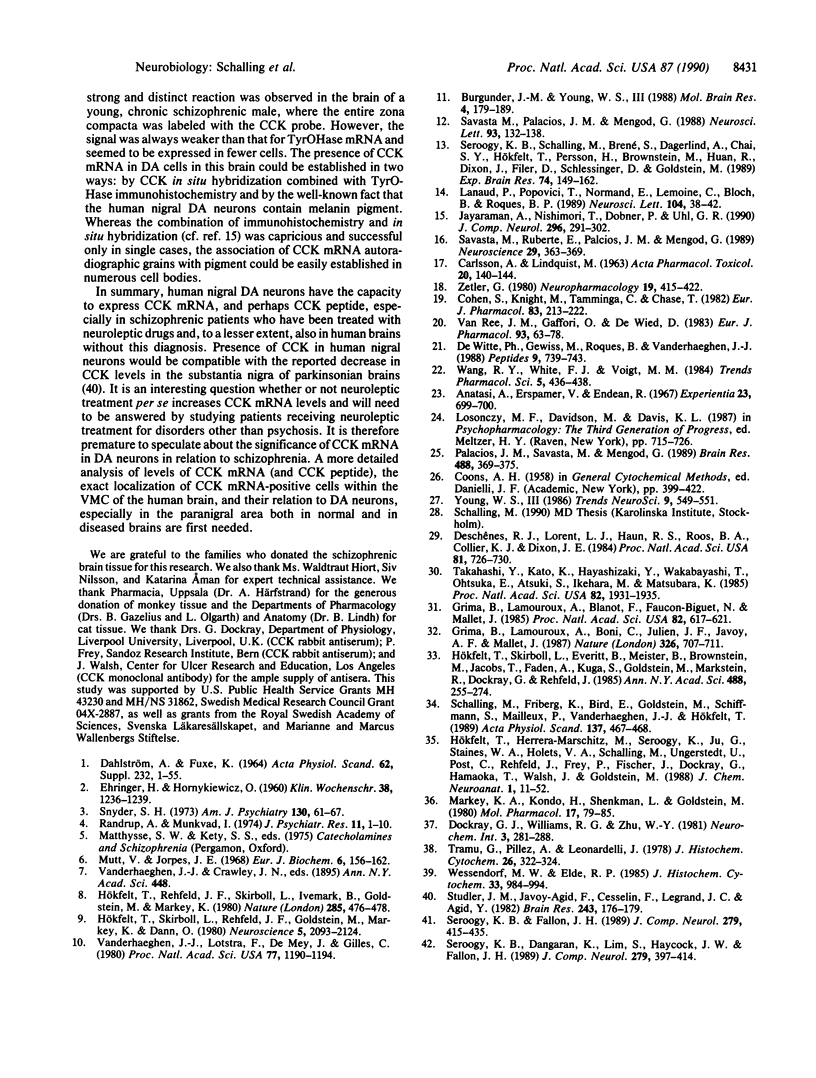
Images in this article
Selected References
These references are in PubMed. This may not be the complete list of references from this article.
- Anastasi A., Erspamer V., Endean R. Isolation and structure of caerulein, an active decapeptide from the skin of Hyla caerulea. Experientia. 1967 Sep 15;23(9):699–700. doi: 10.1007/BF02154119. [DOI] [PubMed] [Google Scholar]
- Burgunder J. M., Young W. S., 3rd The distribution of thalamic projection neurons containing cholecystokinin messenger RNA, using in situ hybridization histochemistry and retrograde labeling. Brain Res. 1988 Nov;464(3):179–189. doi: 10.1016/0169-328x(88)90024-1. [DOI] [PubMed] [Google Scholar]
- COONS A. H. Fluorescent antibody methods. Gen Cytochem Methods. 1958;1:399–422. [PubMed] [Google Scholar]
- Cohen S. L., Knight M., Tamminga C. A., Chase T. N. Cholecystokinin-octapeptide effects on conditioned-avoidance behavior, stereotypy and catalepsy. Eur J Pharmacol. 1982 Sep 24;83(3-4):213–222. doi: 10.1016/0014-2999(82)90254-0. [DOI] [PubMed] [Google Scholar]
- De Witte P., Gewiss M., Roques B., Vanderhaeghen J. J. Neuroleptic-like properties of cholecystokinin analogs: distinctive mechanisms underlying similar behavioral profiles depending on the route of administration. Peptides. 1988 Jul-Aug;9(4):739–743. doi: 10.1016/0196-9781(88)90115-5. [DOI] [PubMed] [Google Scholar]
- Deschenes R. J., Lorenz L. J., Haun R. S., Roos B. A., Collier K. J., Dixon J. E. Cloning and sequence analysis of a cDNA encoding rat preprocholecystokinin. Proc Natl Acad Sci U S A. 1984 Feb;81(3):726–730. doi: 10.1073/pnas.81.3.726. [DOI] [PMC free article] [PubMed] [Google Scholar]
- EHRINGER H., HORNYKIEWICZ O. [Distribution of noradrenaline and dopamine (3-hydroxytyramine) in the human brain and their behavior in diseases of the extrapyramidal system]. Klin Wochenschr. 1960 Dec 15;38:1236–1239. doi: 10.1007/BF01485901. [DOI] [PubMed] [Google Scholar]
- Grima B., Lamouroux A., Blanot F., Biguet N. F., Mallet J. Complete coding sequence of rat tyrosine hydroxylase mRNA. Proc Natl Acad Sci U S A. 1985 Jan;82(2):617–621. doi: 10.1073/pnas.82.2.617. [DOI] [PMC free article] [PubMed] [Google Scholar]
- Grima B., Lamouroux A., Boni C., Julien J. F., Javoy-Agid F., Mallet J. A single human gene encoding multiple tyrosine hydroxylases with different predicted functional characteristics. Nature. 1987 Apr 16;326(6114):707–711. doi: 10.1038/326707a0. [DOI] [PubMed] [Google Scholar]
- Hökfelt T., Herrera-Marschitz M., Seroogy K., Ju G., Staines W. A., Holets V., Schalling M., Ungerstedt U., Post C., Rehfeld J. F. Immunohistochemical studies on cholecystokinin (CCK)-immunoreactive neurons in the rat using sequence specific antisera and with special reference to the caudate nucleus and primary sensory neurons. J Chem Neuroanat. 1988 Jan-Feb;1(1):11–51. [PubMed] [Google Scholar]
- Hökfelt T., Rehfeld J. F., Skirboll L., Ivemark B., Goldstein M., Markey K. Evidence for coexistence of dopamine and CCK in meso-limbic neurones. Nature. 1980 Jun 12;285(5765):476–478. doi: 10.1038/285476a0. [DOI] [PubMed] [Google Scholar]
- Hökfelt T., Skirboll L., Everitt B., Meister B., Brownstein M., Jacobs T., Faden A., Kuga S., Goldstein M., Markstein R. Distribution of cholecystokinin-like immunoreactivity in the nervous system. Co-existence with classical neurotransmitters and other neuropeptides. Ann N Y Acad Sci. 1985;448:255–274. doi: 10.1111/j.1749-6632.1985.tb29922.x. [DOI] [PubMed] [Google Scholar]
- Hökfelt T., Skirboll L., Rehfeld J. F., Goldstein M., Markey K., Dann O. A subpopulation of mesencephalic dopamine neurons projecting to limbic areas contains a cholecystokinin-like peptide: evidence from immunohistochemistry combined with retrograde tracing. Neuroscience. 1980;5(12):2093–2124. doi: 10.1016/0306-4522(80)90127-x. [DOI] [PubMed] [Google Scholar]
- Jayaraman A., Nishimori T., Dobner P., Uhl G. R. Cholecystokinin and neurotensin mRNAs are differentially expressed in subnuclei of the ventral tegmental area. J Comp Neurol. 1990 Jun 8;296(2):291–302. doi: 10.1002/cne.902960209. [DOI] [PubMed] [Google Scholar]
- Lanaud P., Popovici T., Normand E., Lemoine C., Bloch B., Roques B. P. Distribution of CCK mRNA in particular regions (hippocampus, periaqueductal grey and thalamus) of the rat by in situ hybridization. Neurosci Lett. 1989 Sep 25;104(1-2):38–42. doi: 10.1016/0304-3940(89)90325-x. [DOI] [PubMed] [Google Scholar]
- Markey K. A., Kondo H., Shenkman L., Goldstein M. Purification and characterization of tyrosine hydroxylase from a clonal pheochromocytoma cell line. Mol Pharmacol. 1980 Jan;17(1):79–85. [PubMed] [Google Scholar]
- Mutt V., Jorpes J. E. Structure of porcine cholecystokinin-pancreozymin. 1. Cleavage with thrombin and with trypsin. Eur J Biochem. 1968 Oct 17;6(1):156–162. doi: 10.1111/j.1432-1033.1968.tb00433.x. [DOI] [PubMed] [Google Scholar]
- Palacios J. M., Savasta M., Mengod G. Does cholecystokinin colocalize with dopamine in the human substantia nigra? Brain Res. 1989 May 29;488(1-2):369–375. doi: 10.1016/0006-8993(89)90733-6. [DOI] [PubMed] [Google Scholar]
- Randrup A., Munkvad I. Pharmacology and physiology of stereotyped behavior. J Psychiatr Res. 1974;11:1–10. doi: 10.1016/0022-3956(74)90062-4. [DOI] [PubMed] [Google Scholar]
- Savasta M., Palacios J. M., Mengod G. Regional localization of the mRNA coding for the neuropeptide cholecystokinin in the rat brain studied by in situ hybridization. Neurosci Lett. 1988 Nov 11;93(2-3):132–138. doi: 10.1016/0304-3940(88)90070-5. [DOI] [PubMed] [Google Scholar]
- Savasta M., Ruberte E., Palacios J. M., Mengod G. The colocalization of cholecystokinin and tyrosine hydroxylase mRNAs in mesencephalic dopaminergic neurons in the rat brain examined by in situ hybridization. Neuroscience. 1989;29(2):363–369. doi: 10.1016/0306-4522(89)90063-8. [DOI] [PubMed] [Google Scholar]
- Schalling M., Friberg K., Bird E., Goldstein M., Schiffmann S., Mailleux P., Vanderhaeghen J. J., Hökfelt T. Presence of cholecystokinin mRNA in dopamine cells in the ventral mesencephalon of a human with schizophrenia. Acta Physiol Scand. 1989 Nov;137(3):467–468. doi: 10.1111/j.1748-1716.1989.tb08782.x. [DOI] [PubMed] [Google Scholar]
- Seroogy K. B., Dangaran K., Lim S., Haycock J. W., Fallon J. H. Ventral mesencephalic neurons containing both cholecystokinin- and tyrosine hydroxylase-like immunoreactivities project to forebrain regions. J Comp Neurol. 1989 Jan 15;279(3):397–414. doi: 10.1002/cne.902790306. [DOI] [PubMed] [Google Scholar]
- Seroogy K. B., Fallon J. H. Forebrain projections from cholecystokininlike-immunoreactive neurons in the rat midbrain. J Comp Neurol. 1989 Jan 15;279(3):415–435. doi: 10.1002/cne.902790307. [DOI] [PubMed] [Google Scholar]
- Seroogy K., Schalling M., Brené S., Dagerlind A., Chai S. Y., Hökfelt T., Persson H., Brownstein M., Huan R., Dixon J. Cholecystokinin and tyrosine hydroxylase messenger RNAs in neurons of rat mesencephalon: peptide/monoamine coexistence studies using in situ hybridization combined with immunocytochemistry. Exp Brain Res. 1989;74(1):149–162. doi: 10.1007/BF00248288. [DOI] [PubMed] [Google Scholar]
- Snyder S. H. Amphetamine psychosis: a "model" schizophrenia mediated by catecholamines. Am J Psychiatry. 1973 Jan;130(1):61–67. doi: 10.1176/ajp.130.1.61. [DOI] [PubMed] [Google Scholar]
- Studler J. M., Javoy-Agid F., Cesselin F., Legrand J. C., Agid Y. CCK-8-Immunoreactivity distribution in human brain: selective decrease in the substantia nigra from parkinsonian patients. Brain Res. 1982 Jul 8;243(1):176–179. doi: 10.1016/0006-8993(82)91135-0. [DOI] [PubMed] [Google Scholar]
- Takahashi Y., Kato K., Hayashizaki Y., Wakabayashi T., Ohtsuka E., Matsuki S., Ikehara M., Matsubara K. Molecular cloning of the human cholecystokinin gene by use of a synthetic probe containing deoxyinosine. Proc Natl Acad Sci U S A. 1985 Apr;82(7):1931–1935. doi: 10.1073/pnas.82.7.1931. [DOI] [PMC free article] [PubMed] [Google Scholar]
- Tramu G., Pillez A., Leonardelli J. An efficient method of antibody elution for the successive or simultaneous localization of two antigens by immunocytochemistry. J Histochem Cytochem. 1978 Apr;26(4):322–324. doi: 10.1177/26.4.207771. [DOI] [PubMed] [Google Scholar]
- Van Ree J. M., Gaffori O., De Wied D. In rats, the behavioral profile of CCK-8 related peptides resembles that of antipsychotic agents. Eur J Pharmacol. 1983 Sep 16;93(1-2):63–78. doi: 10.1016/0014-2999(83)90031-6. [DOI] [PubMed] [Google Scholar]
- Vanderhaeghen J. J., Lotstra F., De Mey J., Gilles C. Immunohistochemical localization of cholecystokinin- and gastrin-like peptides in the brain and hypophysis of the rat. Proc Natl Acad Sci U S A. 1980 Feb;77(2):1190–1194. doi: 10.1073/pnas.77.2.1190. [DOI] [PMC free article] [PubMed] [Google Scholar]
- Wessendorf M. W., Elde R. P. Characterization of an immunofluorescence technique for the demonstration of coexisting neurotransmitters within nerve fibers and terminals. J Histochem Cytochem. 1985 Oct;33(10):984–994. doi: 10.1177/33.10.2413102. [DOI] [PubMed] [Google Scholar]
- Zetler G. Analgesia and ptosis caused by caerulein and cholecystokinin octapeptide (CCK-8). Neuropharmacology. 1980 May;19(5):415–422. doi: 10.1016/0028-3908(80)90047-7. [DOI] [PubMed] [Google Scholar]





